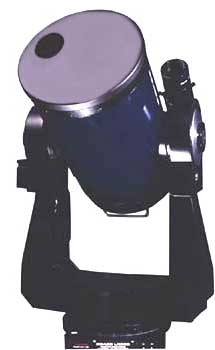 Large telescopes often have a problem when looking at the Moon or planets. They gather too much light. The Moon and planets are bright enough on their own. You don't need to gather a lot of light to see them.
Large telescopes often have a problem when looking at the Moon or planets. They gather too much light. The Moon and planets are bright enough on their own. You don't need to gather a lot of light to see them.
If an image is too bright, a property called irradiation comes into play within your eye. Irradiation causes bright areas to bleed over into adjoining dark areas and soften or eliminate the border between them. For example, when two bright areas are separated by a thin dark area, such as a narrow rille on the Moon, the irradiation of the two bright areas can cause the thin dark rille to disappear. With a big scope, then, trying to see faint details in a planet's atmosphere or on its surface is often like trying to read the brand name on a car headlight at night when it's lit. There's just too much glare to see any detail. In addition, big scopes look through more of our atmosphere than small scopes and are often limited in their ability to resolve small details by conditions in our turbulent atmosphere.
An aperture mask is a circular piece of cardboard or metal the same size as the front cell of your telescope. A 3" to 4" circular hole is cut into the mask off to one side, not directly in the center of the cardboard circle. The mask is painted flat black and taped over the front of your scope. If properly sized and positioned, the circular hole will line up with an unobstructed portion of your scope's optical tube. It will not be blocked by the edge of the tube or the secondary mirror, and none of the secondary mirror's spider vanes or support structure will cut across the circular hole. By masking down the aperture of a large telescope you reduce the brightness and glare, reducing irradiation, You eliminate the diffraction effects of the secondary mirror and its supports, improving contrast. And you reduce the image-blurring effects of atmospheric turbulence, sharpening the image.
An aperture mask reduces the resolution of a large scope to that of an unobstructed refractor with the same aperture as the size of the hole cut in the mask. However, most observers would rather have a sharp steady image with reduced resolution than a blindingly bright image that's too fuzzy and washed out to see any details. An aperture mask gives them a sharp steady image with a big scope.
A neutral density eyepiece filter will also reduce the image brightness, reducing irradiation. However, it does not reduce the diffraction effects of spider vanes or the secondary mirror and does not reduce the effect of atmospheric turbulence. A filter can also reduce the resolution slightly at high powers.








